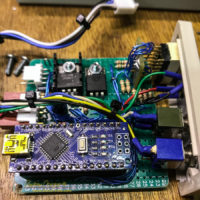The usual drill… A problem that can be solved by a bit of circuitry. In this case the gals in the lab were having trouble controlling the mix of gas to their cultures. They needed to feed much less CO2 to the mix, where the off-the-shelf flow gauges and needle valves became difficult to use much under one liter-per-minute.
Simple solution… Build a gas modulator, something that could turn on the gas some percent of the time, allowing easy control of small amounts of CO2 to the mix. A timer and a gas solenoid… Easy.
There is nothing particularly interesting about the circuitry. A seven segment display, a few switches, and a power transistor to control an external solenoid. All very basic. It is the controller that is new, at least for me. An Arduino provides the programmable part of this project.
This is the first time I have ever used an Arduino. While I am an old veteran of microcontrollers, programming assembly since I was a teenager decades ago, I had somehow avoided using the most popular microcontroller platform of the modern maker community. Instead, when I needed a micro, I pulled out a Microchip PIC, a platform I have likewise used for decades and am very comfortable with.
The Arduino proved to be as easy to use as expected, fairly painless actually. The specific device here is an Arduino Nano, chosen simply as there were a bunch sitting around the company workshop and I decided to try one out.
The Arduino programming language is simple, and provided the needed features for this particular project. Old skills in programming made it a simple matter to write what turned out to be quite short. I just needed to locate the functions I required in the Ardiuno simplified C programming language, functions I knew would be there.
Aside from one issue with a comparison that used different types causing the program to behave erratically, programming went very smoothly. I have programmed too much Python lately, where variable types and casting are handled automatically. I would need to get back into C habits if I were to program more Arduino code.
The device is now sitting in the lab, happily controlling a gas solenoid squirting CO2 into the mix. Another little project success. How many of my little microcontroller projects are out there in the world? More than I remember.



